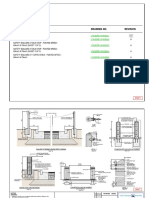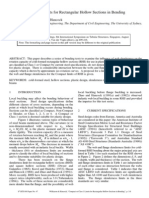About Pushover Analysis and SAP 2000 Method
About Pushover Analysis and SAP 2000 Method
Uploaded by
Hanush AnandCopyright:
Available Formats
About Pushover Analysis and SAP 2000 Method
About Pushover Analysis and SAP 2000 Method
Uploaded by
Hanush AnandOriginal Description:
Copyright
Available Formats
Share this document
Did you find this document useful?
Is this content inappropriate?
Copyright:
Available Formats
About Pushover Analysis and SAP 2000 Method
About Pushover Analysis and SAP 2000 Method
Uploaded by
Hanush AnandCopyright:
Available Formats
4/5/2012
1
Using SAP2000 Software Package in
Earthquake Engineering (Part II: Pushover)
Sameframebut
differentloading
Q
D
=4.5kips/ft
Q
D
=10.5kips/ft
Q
D
=10.5kips/ft
Loads on structures:
- Static (e.g. self-weight)
- Dynamic (e.g. earthquake)
Structures response:
Linear (constant stiffness) - Linear (constant stiffness)
- Nonlinear (variable stiffness)
Structural Analysis Approaches:
- Linear static (ELF)
(least accurate; least complex) ( p )
- Linear dynamic (response spectra)
- Nonlinear static (pushover)
- Nonlinear dynamic (time history)
(most accurate; most complex)
4/5/2012
2
Pushover analysis:
Applying a force distribution force distribution to the structure in an
incremental fashion while monitoring the
occurrence of nonlinear behavior nonlinear behavior and plotting the
base shear (V
b
) versus control node control node displacement
(u
N
).
compromise the simplicity of linear static approaches
and accuracy of nonlinear dynamic methods.
1- Nonlinearity sources:
- Geometrical (P-Delta effects)
(consider or not: codes)
- Material
(too many materials behavior models) (too many materials behavior models)
2- Nonlinearity modeling:
- Concentrated - Distributed
4/5/2012
3
Plastic hinge properties:
- running section analysis and coming up with M- curves
Plastic hinge properties:
- using codes tabulated properties
4/5/2012
4
3- Lateral load pattern:
- a single concentrated force at the top
(good for one-story buildings)
- in proportion to the standard code procedure:
in proportion to the product of story masses and
( )
/ x x x x x F wh wh V =
- in proportion to the product of story masses and
predominant mode shape of the elastic model of the
structure
( )
/ x x x x x F w w V = u u
4- Control node:
- For common buildings, the control node could be
selected as roof (top) story node
h l i i d h h h - Pushover analysis is stopped when the structure reaches:
pre-defined displacement
or
ultimate capacity
5- Gravity loads should be applied prior to the
application of lateral loads
4/5/2012
5
6- Check at performance point :
The global response of the structure and individual
component deformations are compared to limits in
li ht f th ifi f l f th t light of the specific performance goals of the system
Using SAP2000 for Pushover Analysis
We will use the same frame (elastic beams), just
modify dead loads:
4/5/2012
6
1- Run Modal Analysis
( 1 )
1 . 0
0 . 7 5 9 |
=
`
0 . 3 4 5
)
1 0 0 0
Select lateral load pattern:
7 5 9
3 4 5
x
F k i ps
=
`
)
2- Lateral Load Case
4/5/2012
7
3- Modify Dead Load Case
3- Define Push Load Case
1
2
4/5/2012
8
3- Define Push Load Case
1 2
4- Assign Plastic Hinges
Select column elements:
4/5/2012
9
4- Assign Plastic Hinges
4- Assign Plastic Hinges
Select beam elements:
4/5/2012
10
5- Run
6- Results Output
Display displacement:
4/5/2012
11
6- Results Output
Display pushover curve:
7- Checking Hinges Status
Looking for 0.5 ft roof displacement:
4/5/2012
12
7- Checking Hinges Status
At 0.5 ft roof displacement: the performance level
of the system is Collapse Prevention (CP)
You might also like
- FB-Pier Users Guide and Manual SVDocument152 pagesFB-Pier Users Guide and Manual SVroddick13100% (3)
- SS Cse 01Document191 pagesSS Cse 01Senthil SivasubramaniamNo ratings yet
- ACI Moment Coefficient Design AID PDFDocument13 pagesACI Moment Coefficient Design AID PDFSufian Ahmad50% (4)
- Shear Force in A Beam (Edited) 1Document20 pagesShear Force in A Beam (Edited) 1Ana Jannah80% (5)
- 3.4 Pushover AnalysisDocument40 pages3.4 Pushover AnalysisnguyenvanduyetNo ratings yet
- Advanced Opensees Algorithms, Volume 1: Probability Analysis Of High Pier Cable-Stayed Bridge Under Multiple-Support Excitations, And LiquefactionFrom EverandAdvanced Opensees Algorithms, Volume 1: Probability Analysis Of High Pier Cable-Stayed Bridge Under Multiple-Support Excitations, And LiquefactionNo ratings yet
- An Upper-Bound Pushover Analysis Procedure For Estimating The Seismic Demands of High-Rise Buildings PDFDocument12 pagesAn Upper-Bound Pushover Analysis Procedure For Estimating The Seismic Demands of High-Rise Buildings PDFJoaquin Ignacio Concha NúñezNo ratings yet
- Limit State Design of Concrete StructuresDocument76 pagesLimit State Design of Concrete StructuresRadhikaNo ratings yet
- Indian Wind Code - IITK GSDMA Wind05 V1.0Document106 pagesIndian Wind Code - IITK GSDMA Wind05 V1.0Fung MakNo ratings yet
- Seismic Nonlinear DR AlsaadiDocument67 pagesSeismic Nonlinear DR AlsaadiJosias Liriano ThenNo ratings yet
- A Review On Applications of Tuned Liquid Dampers in Vibration ControlDocument17 pagesA Review On Applications of Tuned Liquid Dampers in Vibration ControlBharadwaj NandaNo ratings yet
- NonLinearAnalysis SAP2000Document11 pagesNonLinearAnalysis SAP2000Javier VidalNo ratings yet
- Concept of Response SpectrumDocument74 pagesConcept of Response Spectrumahumanbeing108No ratings yet
- SAP2000 - Nonlinear - Dynamic - Analysis - PDF - 4w P PDFDocument12 pagesSAP2000 - Nonlinear - Dynamic - Analysis - PDF - 4w P PDFjunhe898No ratings yet
- Nonlinear Dynamic Analysis of Reticulated Space Truss StructuresDocument39 pagesNonlinear Dynamic Analysis of Reticulated Space Truss StructuresArjun RajaNo ratings yet
- Time History Analysis MethodDocument8 pagesTime History Analysis MethodSauhardra OjhaNo ratings yet
- Design of Earthquake Resistance BuildingDocument108 pagesDesign of Earthquake Resistance Buildingnagraj204No ratings yet
- Wind Loading in Tall BuildingsDocument11 pagesWind Loading in Tall Buildingsrenganathank87No ratings yet
- Vertical Irregularity.Document6 pagesVertical Irregularity.Vinay KumarNo ratings yet
- Pushover Analysis of Shear-Critical Frames:Verification and ApplicationDocument10 pagesPushover Analysis of Shear-Critical Frames:Verification and ApplicationProfessor Dr. Nabeel Al-Bayati-Consultant EngineerNo ratings yet
- Report On Pushover AnalysisDocument14 pagesReport On Pushover Analysiskandarp majmudar100% (1)
- Time History Analysis of Base Isolated Multi-Storyed BuildingDocument8 pagesTime History Analysis of Base Isolated Multi-Storyed Buildingkartik.123No ratings yet
- Dimensional Analysis and Development of Similitude Rules For Dynamic Structural ModelsDocument5 pagesDimensional Analysis and Development of Similitude Rules For Dynamic Structural ModelsgauravNo ratings yet
- Earthquake-Resistant Design PDFDocument52 pagesEarthquake-Resistant Design PDFivanNo ratings yet
- Along Wind Load On Tall Buildings - Indian Codal ProvisionsDocument8 pagesAlong Wind Load On Tall Buildings - Indian Codal ProvisionsKeshav VaityNo ratings yet
- Paper On Floating ColumnDocument8 pagesPaper On Floating Columnমোঃ হাসান ইমামNo ratings yet
- Ppt-Pushover Analysis Tutorial 6 Revised by NithilDocument23 pagesPpt-Pushover Analysis Tutorial 6 Revised by NithilOscar PeraltaNo ratings yet
- Static Linear and Non Linear (Pushover) Analysis of RC Building On Sloping Grounds On Medium Soils in Different ZonesDocument10 pagesStatic Linear and Non Linear (Pushover) Analysis of RC Building On Sloping Grounds On Medium Soils in Different ZonesIAEME PublicationNo ratings yet
- Non-Linear Static (Pushover) AnalysisDocument3 pagesNon-Linear Static (Pushover) AnalysisAnonymous 4emDZITjoNo ratings yet
- ACiDocument9 pagesACiMarcel SteoleaNo ratings yet
- Transfer PlateDocument10 pagesTransfer PlateAlex Ferrari100% (1)
- L1 - MRCS - Embedded Metal Corrosion - 1Document30 pagesL1 - MRCS - Embedded Metal Corrosion - 1Kaushal Kumar100% (1)
- Structural Analysis and Design of Residential Building Using ETABSDocument12 pagesStructural Analysis and Design of Residential Building Using ETABSSushil GunagaNo ratings yet
- Pushover Procedure For Seismic Analysis of BuildingsDocument8 pagesPushover Procedure For Seismic Analysis of BuildingsOdair Tonatiu Martínez ReyesNo ratings yet
- New Seismic Design Provisions in JapanDocument19 pagesNew Seismic Design Provisions in JapanBrian Taylor100% (1)
- RC Frame Building With Masonry Infill Walls Designed For Gravity LoadsDocument16 pagesRC Frame Building With Masonry Infill Walls Designed For Gravity LoadsFeras TemimiNo ratings yet
- Initial P-Delta Analysis ETABSDocument1 pageInitial P-Delta Analysis ETABSkatherineqj100% (1)
- Seismic Design To EC8 - L3Document18 pagesSeismic Design To EC8 - L3Chamil MahagamageNo ratings yet
- Cost-Effective Piled-Raft Foundation For High-Rise BuildingDocument8 pagesCost-Effective Piled-Raft Foundation For High-Rise Buildingxheurtaux100% (1)
- Pasticier - Nonlinear - Seismic - Analysis of A Masonry Building in SAP2000Document19 pagesPasticier - Nonlinear - Seismic - Analysis of A Masonry Building in SAP2000Marcos Di SierviNo ratings yet
- Chapter 8-Earth Retaining Structures-13Document23 pagesChapter 8-Earth Retaining Structures-13Alexander AlexanderNo ratings yet
- Etabs SoftwareDocument14 pagesEtabs SoftwareD.RamyasreeNo ratings yet
- Stability With Perched Water TableDocument5 pagesStability With Perched Water TableJavier Andres Martinez OrtegaNo ratings yet
- Advanced Earthquake Resisting TechniquesDocument14 pagesAdvanced Earthquake Resisting TechniquesPrashant SunagarNo ratings yet
- Lecture-Introduction To EC2Document48 pagesLecture-Introduction To EC2denyfate100% (1)
- Unit 3Document29 pagesUnit 3ashok Pradhan100% (1)
- Steel Structure Chapter 1Document11 pagesSteel Structure Chapter 1Kiệt ĐỗNo ratings yet
- Check ListDocument3 pagesCheck Listtaw1021966m0% (1)
- Earthquake-Resistant Design of Open Ground Storey RC Framed BuildingsDocument8 pagesEarthquake-Resistant Design of Open Ground Storey RC Framed BuildingsHemant SonawadekarNo ratings yet
- Structural Engineering DocumentsFrom EverandStructural Engineering DocumentsJorge de BritoNo ratings yet
- A Catalogue of Details on Pre-Contract Schedules: Surgical Eye Centre of Excellence - KathFrom EverandA Catalogue of Details on Pre-Contract Schedules: Surgical Eye Centre of Excellence - KathNo ratings yet
- Using SAP2000 Software Package in Earthquake Engineering (Part II Pushover)Document12 pagesUsing SAP2000 Software Package in Earthquake Engineering (Part II Pushover)langchenNo ratings yet
- H1c. Second Presentation 1per PageDocument23 pagesH1c. Second Presentation 1per PageAnonymous PDEpTC4No ratings yet
- Pile Foundations - Introduction: Vertical Load-Bearing Capacity of Pile Foundations Is Determined Using Various MethodsDocument8 pagesPile Foundations - Introduction: Vertical Load-Bearing Capacity of Pile Foundations Is Determined Using Various MethodsMehedi HasanNo ratings yet
- Engi Neeri NG Manual SDocument66 pagesEngi Neeri NG Manual SMaria Veronica GuevaraNo ratings yet
- 13 Pile Foundations IntroductionDocument8 pages13 Pile Foundations Introductionseljak_veseljakNo ratings yet
- Axisvm AdvancedstepbystepbookDocument84 pagesAxisvm Advancedstepbystepbookmerea.mircea.rNo ratings yet
- Civil2015 v2 1 Release NoteDocument30 pagesCivil2015 v2 1 Release NoteJorge Luis Molluni BalconaNo ratings yet
- Gen741 PushoverUserGuideDocument105 pagesGen741 PushoverUserGuideSergiovichNo ratings yet
- Basics of Nonlinear Pushover AnalysisDocument3 pagesBasics of Nonlinear Pushover AnalysisRafiqulIslamNo ratings yet
- 7.2 Foundation Modeling For Seismic Loads: 7.2.1 GeneralDocument12 pages7.2 Foundation Modeling For Seismic Loads: 7.2.1 GenerallingamkumarNo ratings yet
- MST For Concrete RepairDocument6 pagesMST For Concrete RepairDelta akathehusky100% (1)
- BARNALA BRIDGE PLAN 25-07-2020-ModelDocument1 pageBARNALA BRIDGE PLAN 25-07-2020-ModelEr Navneet JassiNo ratings yet
- Rebar Arrangement in SlabDocument12 pagesRebar Arrangement in Slableovorig100% (2)
- 10 Resolved Exercises Final EbookDocument19 pages10 Resolved Exercises Final EbookTony LeNo ratings yet
- Ict NotesDocument3 pagesIct NotesmaganolefikaNo ratings yet
- BOQ DescriptionsDocument8 pagesBOQ Descriptionsnayanahari100% (1)
- Beam Bending FormulaDocument22 pagesBeam Bending FormulaBeniamine SarmientoNo ratings yet
- Sdre14-14 Bol 1-5-Rev17Document6 pagesSdre14-14 Bol 1-5-Rev17Jan UmaliNo ratings yet
- Vernacular StructuresDocument31 pagesVernacular StructuresEr Krishan YadavNo ratings yet
- Pricelist: Product CatalogueDocument20 pagesPricelist: Product CatalogueunjotacheNo ratings yet
- Lakshmi Narayana V KDocument10 pagesLakshmi Narayana V KBhargav KNo ratings yet
- NCMA Technical NotesDocument6 pagesNCMA Technical Notesklb75No ratings yet
- 4 Pure BendingDocument42 pages4 Pure BendingOmarfirozNo ratings yet
- 1996-Byrne-Anderson-Jitno Seismic Analysis of Large Buried Culvert StructuresDocument7 pages1996-Byrne-Anderson-Jitno Seismic Analysis of Large Buried Culvert StructureshjitnoNo ratings yet
- Hawassa University: Department of Hydraulic and Water Resources EngineeringDocument2 pagesHawassa University: Department of Hydraulic and Water Resources EngineeringAmanuel AlemayehuNo ratings yet
- Typical Truss Detail: S T A I R D E T A I LDocument1 pageTypical Truss Detail: S T A I R D E T A I LJOHNBNo ratings yet
- Part 1-5 - PowerpointsDocument160 pagesPart 1-5 - PowerpointsChrispin BarnigoNo ratings yet
- Brochure - J. VazcoDocument2 pagesBrochure - J. Vazcojoshua.kmbanayatNo ratings yet
- Post TensioningDocument3 pagesPost TensioningMaheerah Gamieldien-MohamedNo ratings yet
- Behaviour of Skew BridgeDocument7 pagesBehaviour of Skew BridgeSohan George100% (1)
- TTTTDocument4 pagesTTTTIshwar ChauhanNo ratings yet
- Introduction To Geotechnical Structural Design (Pile Design) According To American StandardsDocument28 pagesIntroduction To Geotechnical Structural Design (Pile Design) According To American StandardsUtaya Kumar VeelmuruganNo ratings yet
- Rezistenta Termica Pe ElementeDocument50 pagesRezistenta Termica Pe ElementeDavid SocaciuNo ratings yet
- Compact or Class 1 Limits For Rectangular Hollow Sections in BendingDocument8 pagesCompact or Class 1 Limits For Rectangular Hollow Sections in BendingKolumbán ZoltánNo ratings yet
- Module 3Document38 pagesModule 3Suryakant MangajNo ratings yet
- DeepbeamDocument4 pagesDeepbeamshna jabarNo ratings yet
- Issued For BP - Structural - 19Document1 pageIssued For BP - Structural - 19Tran DtrungNo ratings yet
- Building DrawingDocument25 pagesBuilding DrawingTheophilus AmponsahNo ratings yet

























































































